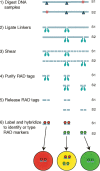Rapid and cost-effective polymorphism identification and genotyping using restriction site associated DNA (RAD) markers
- PMID: 17189378
- PMCID: PMC1781356
- DOI: 10.1101/gr.5681207
Rapid and cost-effective polymorphism identification and genotyping using restriction site associated DNA (RAD) markers
Abstract
Restriction site associated DNA (RAD) tags are a genome-wide representation of every site of a particular restriction enzyme by short DNA tags. Most organisms segregate large numbers of DNA sequence polymorphisms that disrupt restriction sites, which allows RAD tags to serve as genetic markers spread at a high density throughout the genome. Here, we demonstrate the applicability of RAD markers for both individual and bulk-segregant genotyping. First, we show that these markers can be identified and typed on pre-existing microarray formats. Second, we present a method that uses RAD marker DNA to rapidly produce a low-cost microarray genotyping resource that can be used to efficiently identify and type thousands of RAD markers. We demonstrate the utility of the former approach by using a tiling path array for the fruit fly to map a recombination breakpoint, and the latter approach by creating and using an enriched RAD marker array for the threespine stickleback. The high number of RAD markers enabled localization of a previously identified region, as well as a second region also associated with the lateral plate phenotype. Taken together, our results demonstrate that RAD markers, and the method to develop a RAD marker microarray resource, allow high-throughput, high-resolution genotyping in both model and nonmodel systems.
Figures





References
-
- Bell M.A., Foster S.A., Foster S.A. The evolutionary biology of the threespine stickleback. Oxford University Press; Oxford, New York: 1994.
-
- Birney E., Andrews D., Caccamo M., Chen Y., Clarke L., Coates G., Cox T., Cunningham F., Curwen V., Cutts T., Andrews D., Caccamo M., Chen Y., Clarke L., Coates G., Cox T., Cunningham F., Curwen V., Cutts T., Caccamo M., Chen Y., Clarke L., Coates G., Cox T., Cunningham F., Curwen V., Cutts T., Chen Y., Clarke L., Coates G., Cox T., Cunningham F., Curwen V., Cutts T., Clarke L., Coates G., Cox T., Cunningham F., Curwen V., Cutts T., Coates G., Cox T., Cunningham F., Curwen V., Cutts T., Cox T., Cunningham F., Curwen V., Cutts T., Cunningham F., Curwen V., Cutts T., Curwen V., Cutts T., Cutts T., et al. Ensembl 2006. Nucleic Acids Res. 2006;34:D556–D561. - PMC - PubMed
-
- Borevitz J.O., Liang D., Plouffe D., Chang H.S., Zhu T., Weigel D., Berry C.C., Winzeler E., Chory J., Liang D., Plouffe D., Chang H.S., Zhu T., Weigel D., Berry C.C., Winzeler E., Chory J., Plouffe D., Chang H.S., Zhu T., Weigel D., Berry C.C., Winzeler E., Chory J., Chang H.S., Zhu T., Weigel D., Berry C.C., Winzeler E., Chory J., Zhu T., Weigel D., Berry C.C., Winzeler E., Chory J., Weigel D., Berry C.C., Winzeler E., Chory J., Berry C.C., Winzeler E., Chory J., Winzeler E., Chory J., Chory J. Large-scale identification of single-feature polymorphisms in complex genomes. Genome Res. 2003;13:513–523. - PMC - PubMed
Publication types
MeSH terms
Substances
Grants and funding
LinkOut - more resources
Full Text Sources
Other Literature Sources
Molecular Biology Databases
